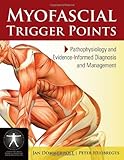Myofascial Trigger Points: Pathophysiology and Evidence-Informed Diagnosis and Management (Contemporary Issues in Physical Therapy and Rehabilitation Medicine)

Myofascial Trigger Points: Pathophysiology and Evidence-Informed Diagnosis and Management examines a special topic, JMMT. Emphasis is on the etiology of trigger points with a critical overview of current concepts. The contributing authors are the most respected myofascial pain research and practice experts. The authors address the etiology of trigger points, the epidemiology of myofascial pain, clinical management of patients, specific treatment issues, and the role of trigger points in various
List Price: $ 61.95
Price: $ 34.04
 Myofascial Trigger Points: Pathophysiology and Evidence-Informed Diagnosis and Management examines a special topic, JMMT. Emphasis is on the etiology of trigger points with a critical overview of current concepts. The contributing authors are the most respected myofascial pain research and practice experts. The authors address the etiology of trigger points, the epidemiology of myofascial pain, clinical management of patients, specific treatment issues, and the role of trigger points in various
Myofascial Trigger Points: Pathophysiology and Evidence-Informed Diagnosis and Management examines a special topic, JMMT. Emphasis is on the etiology of trigger points with a critical overview of current concepts. The contributing authors are the most respected myofascial pain research and practice experts. The authors address the etiology of trigger points, the epidemiology of myofascial pain, clinical management of patients, specific treatment issues, and the role of trigger points in various
This book inaccurately represents acupuncture.,
Please see Table 9.9 for reference.
To become an acupuncturist you must undergo serious and extensive training in diagnosis, anatomy and Western medicine, before getting licensed, nationally and through the state. This book attempts to undermine what acupuncturists are qualified to do by stating that acupuncturists do not have this training. This is not correct, plain and simple.
Was this review helpful to you?

|
Myofacial trigger points,
Horrible!!!
don’t waist one second reading this propaganda…
First bad review I’ve ever written. This author needs to work through his prejudices.
Was this review helpful to you?

|
Terribly biased and under-researched,
I can’t believe these authors would claim that a medical diagnosis and examination are not necessary for acupuncture. Acupuncturists actually complete a four year Master’s program (as much school as chiropractors) and have extensive knowledge of human anatomy using a very scientific system to access meridians that run through out the body. Dry needling (which is the only form of needling the authors of this book are allowed to do) involves blindly sticking a needle into the flesh around an injured area and thrusting the needle in and out of the body. Many patients unfortunately, get a wrong impression of what acupuncture is, because they are incorrectly informed that dry needling is the same thing. Acupuncture, on the contrary, uses the scientific system of meridians to improve blood and energy flow in the body, increasing the rate of healing. Dry needling has been known to agitate injuries, rather than promote healing.
A reason acupuncture shines above several Western forms of treatment is that a complete medical examination is done with every visit. Most patients find real relief from their acupuncture treatments because of the time their practitioners take to listen to them in order to personally customize the best possible treatment for them, rather than giving them the same pill they gave the last five patients they saw that day. Each treatment is carefully designed to suit the current patient.
This book claims that meridians are non-scientific and based off of Chinese philosophy, however recent studies in 2009 using extremely powerful microscopes have actually taken photographs of the meridians that only acupuncturists use (dry needling does not involve meridian therapy). Although Chinese Acupuncture may seem foreign to a lot of folks who are used to a Western style of medicine, acupuncture is a system that has been developing for 4,000 years. It is the oldest form of medicine to date and it is currently practiced in public hospitals, physical and occupational therapy offices and private practices alike. It has endured so many years and varying cultures, because it works and because the folks who give it a chance, find that they feel better and healthier, that their acute symptoms either lessen or disappear, and that their chronic issues are directly addressed. Acupuncture does not treat only a patient’s symptoms, it treats the cause of a patient’s discomfort so that every treatment, the patient leaves with immediate results.
It is so disappointing to see that professionals such as Dommerholt and Huijbregts would go so far as to bully another professional field, that they clearly know next to nothing about, simply for the sake of pushing their own field. Can’t we all work together? Don’t all forms of medicine have something valuable to offer? I’d be hesitant to accept consultatory help regarding my health from any person who aims to devalue another’s field with no research provided. I find their practices to be highly unprofessional.
Was this review helpful to you?

|